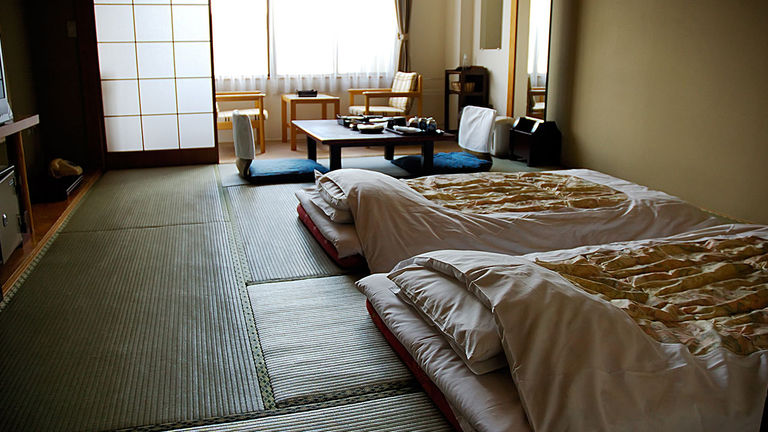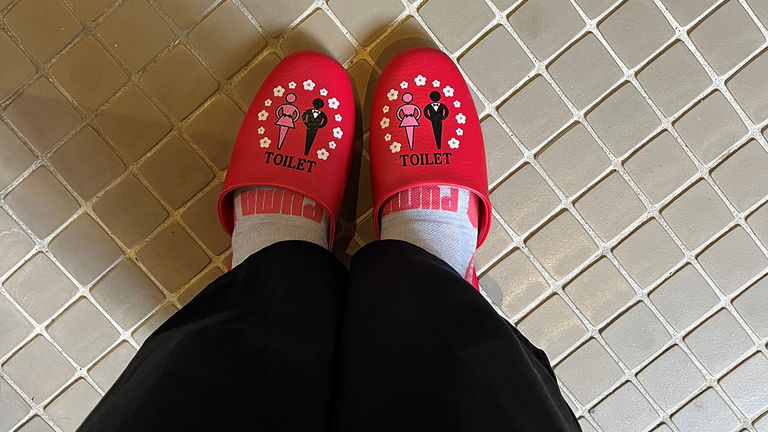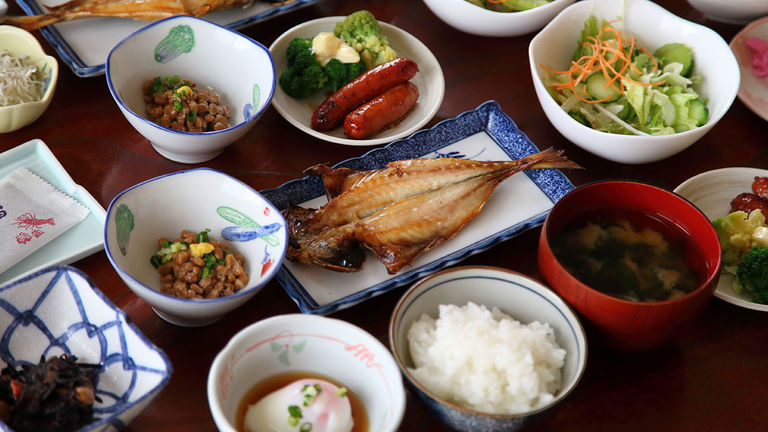As I set foot in Tadaya Ryokan, a traditional Japanese inn (also known as a ryokan), I was overwhelmed by the simplistic beauty of the space. Just beyond my entryway was an indoor stone garden, three large rooms covered with tatami (straw) mats and a cup of steaming matcha tea sitting on the table — a welcome sight after a long day of travel along Ishikawa prefecture’s Noto Peninsula.
But after a self-guided tour of the living and dining rooms, the walk-in closet and the gargantuan bathroom, the panic began to set in.
Where was the bed?
I proceeded to open every pocket door in the suite just in case I had, somehow, missed an entire bedroom. No dice.
After flagging down an employee, I learned that my bed did, in fact, exist — but was in the form of a traditional Japanese futon, which would be set up on the floor during dinner.
As you can probably imagine, I was skeptical of this new arrangement. But that feeling began to dissipate after three more nights at various ryokans within Ishikawa; by the end of my time in Japan, I felt more confident as I became familiar with the inns’ cultural practices, style elements and traditions.
 Traditional Japanese futons are placed on the floor at bedtime.
Traditional Japanese futons are placed on the floor at bedtime.
Credit: 2023 Raolo Marzio/stock.adobe.comBut, to avoid the embarrassment of asking “Where’s the bed?,” there are several things U.S. travelers should prepare for when booking this accommodation option.
Adam Downham, director of the luxury tour division for Beauty of Japan, the destination management company I traveled with during my time in Ishikawa prefecture, says he recommends that first-time visitors book a mix of ryokans and Western-style hotels, noting that the former provides a more immersive cultural experience for travelers.
“Awareness has grown a little, but clients are increasingly receptive to staying in this type of inn when we propose it,” Downham said. “And as long as they go in with the correct expectations, feedback is invariably positive.”
As long as [travelers] go in with the correct expectations, feedback is invariably positive.
Here’s what guests should expect.
Remove Outdoor Shoes
Like most indoor places in Japan, ryokans require the removal of outdoor shoes upon entry. Some inns, including Tachibana Shikitei in Kaga, ask that guests remove their shoes immediately when crossing the lobby’s threshold. Others, such as Mori no Sumika Resort & Spa, also in Kaga, provide lockers in some guestroom hallways.
But wherever shoes are kept, one thing is certain: They should remain off the guestrooms’ tatami floors. Often, wooden indoor slippers and toe socks are provided — which should be worn in the ryokan’s public spaces — and a separate pair of “toilet shoes” are reserved for trips to the loo.
 Toilet shoes, designated for trips to the bathroom, are provided to guests.
Toilet shoes, designated for trips to the bathroom, are provided to guests.
Credit: 2023 Emma WeissmannWear the Inn’s Provided Yukata
In addition to removing shoes, some ryokans ask guests not to wear street clothes while in public spaces, including on-site restaurants, the lobby, entertainment venues, the onsen (public bath) and more. At each ryokan I visited, an okami (manager) helped adjust my provided yukata, which is a casual summer kimono — just be sure to leave underwear on. Written instructions with illustrations on how to wear the yukata are found in most rooms and suites.
Come Hungry, and Expect Elaborate, Multi-Course Meals
It would be a shame to stay at a ryokan without experiencing the inn’s traditional kaiseki (a multi-course Japanese meal), which often leans heavily into seafood, even at breakfast time, and places a focus on visual presentation.
If visitors are uncomfortable with grilled or raw fish for breakfast, it’s best to inquire about alternatives ahead of time.
 Kaiseiki (multi-course Japanese meals) have with a special emphasis on visual presentation.
Kaiseiki (multi-course Japanese meals) have with a special emphasis on visual presentation.
Credit: 2023 174495422/stock.adobe.comBe Mindful of Onsen Bathing Etiquette
Clothing and swimsuits are not allowed in a ryokan’s gender-separated onsen, and all tattoos must be covered. Downham also says visitors must be sure to bathe themselves before entering the bath by using the provided showers, and can use a small towel to cover themselves when not soaking. Recommend that clients wear the towel on their heads, or put it off to the side when entering the baths, as they are not supposed to touch the water.
Qualify Your Clients
Downham says ryokans are best for “anybody who is open-minded, values authenticity and is comfortably mobile.” That said, he notes that modern, Western-style hotels are plentiful in Japan, and may be a better fit for senior guests and families with very young children.
Note: Some ryokans offer Western-style room categories. Inquire with individual properties.